What We’re Reading: January 26th
Guest Editor: Dr. Amey Redkar
 Amey is a postdoc at The Sainsbury Laboratory, Norwich, UK and has been a Plantae Fellow since September 2017. He is working to understand the interaction of plants and pathogens during disease development. His current research which is funded by EMBO Long Term Fellowship focuses on pathogen Albugo candida, which causes serious disease in Brassica crops and aim to understand the role of its virulence proteins. His long- term interest is to dissect cell-specific sensing mechanism in filamentous plant pathogens which will be started later in 2018 with a Marie Skłodowska Curie Fellowship. Read more about his research here
Amey is a postdoc at The Sainsbury Laboratory, Norwich, UK and has been a Plantae Fellow since September 2017. He is working to understand the interaction of plants and pathogens during disease development. His current research which is funded by EMBO Long Term Fellowship focuses on pathogen Albugo candida, which causes serious disease in Brassica crops and aim to understand the role of its virulence proteins. His long- term interest is to dissect cell-specific sensing mechanism in filamentous plant pathogens which will be started later in 2018 with a Marie Skłodowska Curie Fellowship. Read more about his research here
Transposon-derived small RNAs triggered by miR845 mediate genome dosage response in Arabidopsis
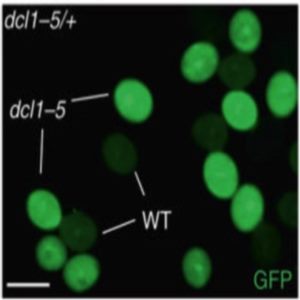 Nat. Genet. Silencing of transposable elements (TEs) is mediated epigenetically by DNA methylation, relying partially on RNA-directed DNA methylation (RdDM). RdDM-induced DNA methylation undergoes a global reprogramming in the male germline, allowing expression of imprinted genes regulating fertility and seed viability. Concomitantly, the production of epigenetically-activated small interfering RNA (easiRNA) from TEs transcripts have been detected, but their biological relevance remains unclear. This study shows that production of TE-derived easiRNA in Arabidopsis pollen is mediated by the targeting of reactivated retrotransposons by microRNA miR485 family. Using a GFP-sensor system including miR485 target site, and thus silenced by easiRNA in pollen, the authors show this phenomenon to be dose-dependent and require RNA polymerase IV, one of the two RNA polymerase involved in RdDM. Remarkably, they show that mutants lacking miR485-dependent easiRNA are less prone to hybridization barrier, between diploid seed parents and tetraploid pollen parents known as triploid block, revealing an important role for easiRNA in regulation of hybridity and speciation. Altogether, this study provides new insights into transposon-derived epigenetic mechanisms to regulation of chromosome dosage and plant development. (Summary by Matthias Benoit) Nat. Genet. 10.1038/s41588-017-0032-5
Nat. Genet. Silencing of transposable elements (TEs) is mediated epigenetically by DNA methylation, relying partially on RNA-directed DNA methylation (RdDM). RdDM-induced DNA methylation undergoes a global reprogramming in the male germline, allowing expression of imprinted genes regulating fertility and seed viability. Concomitantly, the production of epigenetically-activated small interfering RNA (easiRNA) from TEs transcripts have been detected, but their biological relevance remains unclear. This study shows that production of TE-derived easiRNA in Arabidopsis pollen is mediated by the targeting of reactivated retrotransposons by microRNA miR485 family. Using a GFP-sensor system including miR485 target site, and thus silenced by easiRNA in pollen, the authors show this phenomenon to be dose-dependent and require RNA polymerase IV, one of the two RNA polymerase involved in RdDM. Remarkably, they show that mutants lacking miR485-dependent easiRNA are less prone to hybridization barrier, between diploid seed parents and tetraploid pollen parents known as triploid block, revealing an important role for easiRNA in regulation of hybridity and speciation. Altogether, this study provides new insights into transposon-derived epigenetic mechanisms to regulation of chromosome dosage and plant development. (Summary by Matthias Benoit) Nat. Genet. 10.1038/s41588-017-0032-5
SLAM-ITseq: Sequencing cell type-specific transcriptomes without cell sorting
 BioRxiv. Transcriptomic changes at the cellular level are of key importance in specialized cellular types. Therefore, transcriptome analysis at a cell-specific resolution is a powerful tool to learn about biological processes. This analysis is however limited by technological boundaries of microdissection and/or cell sorting methods, such as laser capture microdissection (LCM) or fluorescence-activated cell sorting (FACS). These limitations include intensive time needed, laborious steps and high cell death rate, which limit its successful application to very robust cell-types. Matsushima at al. report a novel sequencing method on living cells that does not make use of previous cell sorting: the SLAM-I(n)T(issue) seq. A new method that improves previously established in vivo 4-thiouracil-based RNA metabolic labelling making it accessible to wider research areas to study cell type-specific transcriptomics, at least in animals. (Summary by Isabel Mendoza) BioRxiv. 10.1101/235093
BioRxiv. Transcriptomic changes at the cellular level are of key importance in specialized cellular types. Therefore, transcriptome analysis at a cell-specific resolution is a powerful tool to learn about biological processes. This analysis is however limited by technological boundaries of microdissection and/or cell sorting methods, such as laser capture microdissection (LCM) or fluorescence-activated cell sorting (FACS). These limitations include intensive time needed, laborious steps and high cell death rate, which limit its successful application to very robust cell-types. Matsushima at al. report a novel sequencing method on living cells that does not make use of previous cell sorting: the SLAM-I(n)T(issue) seq. A new method that improves previously established in vivo 4-thiouracil-based RNA metabolic labelling making it accessible to wider research areas to study cell type-specific transcriptomics, at least in animals. (Summary by Isabel Mendoza) BioRxiv. 10.1101/235093
Drastic genome reduction in an herbivore’s pectinolytic symbiont
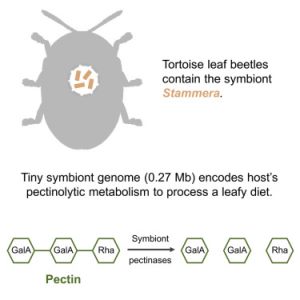 Cell. In a very interesting report, Salem et al., showed evidence of an alternative mechanism supporting how the degradation of pectin, a very hard to metabolize component of the cell wall, has directed the evolution of herbivory in insects and arthropods. Recent reports have indicated that horizontally acquired genes that code for essential metabolites or enzymes, have directed diversification in several insect orders. In addition, other reports suggested that symbioses could be another way to endue animals with adaptations, facilitating their diversification into a broad range of environments. Analysing a leaf beetle, they found that its pectin-degrading phenotype was dependent on an extracellular bacterium, in specialized organs connected to the foregut. Surprisingly, this symbiont contained the smallest genome of any organism not subsisting within a host cell and despite that, a complete and functional metabolism for degradation of homogalacturonan and rhamnogalacturonan I, the most abundant pectin polysaccharides. Furthermore, eliminating this bacterium caused less pectin degradation capacity and reduced survival in the host indicating this symbiosis as a successful strategy for adaptation. (Summary by Maria Julissa Ek-Ramos) Cell. 10.1016/j.cell.2017.10.029
Cell. In a very interesting report, Salem et al., showed evidence of an alternative mechanism supporting how the degradation of pectin, a very hard to metabolize component of the cell wall, has directed the evolution of herbivory in insects and arthropods. Recent reports have indicated that horizontally acquired genes that code for essential metabolites or enzymes, have directed diversification in several insect orders. In addition, other reports suggested that symbioses could be another way to endue animals with adaptations, facilitating their diversification into a broad range of environments. Analysing a leaf beetle, they found that its pectin-degrading phenotype was dependent on an extracellular bacterium, in specialized organs connected to the foregut. Surprisingly, this symbiont contained the smallest genome of any organism not subsisting within a host cell and despite that, a complete and functional metabolism for degradation of homogalacturonan and rhamnogalacturonan I, the most abundant pectin polysaccharides. Furthermore, eliminating this bacterium caused less pectin degradation capacity and reduced survival in the host indicating this symbiosis as a successful strategy for adaptation. (Summary by Maria Julissa Ek-Ramos) Cell. 10.1016/j.cell.2017.10.029
Genome downsizing, physiological novelty, and the global dominance of flowering plants
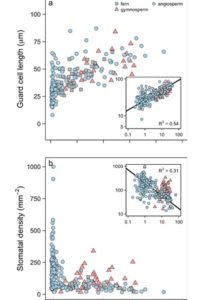 PLOS Biol. Guard cell size is, in general, inversely related to stomatal density. It is advantageous for plants to maximize their photosynthetic capabilities by generating higher rates of gas exchange, thereby incorporating more CO2 to help drive this pathway. However, the number of cells that can occupy a given space is restricted, as defined by cellular allometry. These constraints include genome size, nuclear volume, and cell size. Simonin and Roddy examine the evolutionary relationship between genome size, cell size, stomatal density, and primary productivity across all major clades of terrestrial plants. Smaller genome sizes were attributed to smaller and more densely packed stomata whereas species with larger genomes had larger stomata that were further apart. This variation is genome size to stomatal density was assessed in more detail by examining their associated stomatal conductance rates. Shrinking genomes seen across all species was found to also bring about more efficient/higher rates of stomatal conductance along with faster rates of growth. Additionally, as genome downsizing only allows for smaller cell size, species with this trait can exhibit greater plasticity in final cell size which may facilitate the habitation of a wider range of environmental conditions. This paper adds insight into how angiosperms have achieved rapid ecological domination, outcompeting ferns and gymnosperms. (Summary by Alecia Biel) PLOS Biol. 10.1371/journal.pbio.2003706.
PLOS Biol. Guard cell size is, in general, inversely related to stomatal density. It is advantageous for plants to maximize their photosynthetic capabilities by generating higher rates of gas exchange, thereby incorporating more CO2 to help drive this pathway. However, the number of cells that can occupy a given space is restricted, as defined by cellular allometry. These constraints include genome size, nuclear volume, and cell size. Simonin and Roddy examine the evolutionary relationship between genome size, cell size, stomatal density, and primary productivity across all major clades of terrestrial plants. Smaller genome sizes were attributed to smaller and more densely packed stomata whereas species with larger genomes had larger stomata that were further apart. This variation is genome size to stomatal density was assessed in more detail by examining their associated stomatal conductance rates. Shrinking genomes seen across all species was found to also bring about more efficient/higher rates of stomatal conductance along with faster rates of growth. Additionally, as genome downsizing only allows for smaller cell size, species with this trait can exhibit greater plasticity in final cell size which may facilitate the habitation of a wider range of environmental conditions. This paper adds insight into how angiosperms have achieved rapid ecological domination, outcompeting ferns and gymnosperms. (Summary by Alecia Biel) PLOS Biol. 10.1371/journal.pbio.2003706.
C4 photosynthesis evolved in warm climates but promoted migration to cooler ones
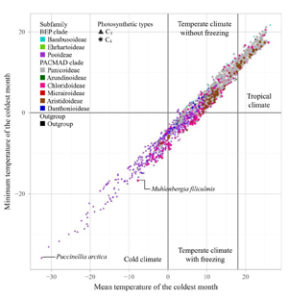 Ecol. Lett. C4 photosynthesis represents a biochemical CO2-concentrating mechanism that increases Rubisco-mediated carboxylation of RuBP and reduces photorespiration. However, there is an energy cost associated with C4 photosynthesis, and so it is presumed to become advantageous over C3 photosynthesis only when levels of photorespiration are high, such as in hot and/or dry environments. This ecological trade-off is reflected in the geographic distribution of C4 species today, with the vast majority restricted to warmer environments. Watcharamongkol et al. employed phylogenetic and distribution data to model whether C4 photosynthesis is poorly adapted to lower temperatures, or whether the evolution of C4 photosynthesis in tropical environments led to the inheritance of other characteristics that have prevented expansion into cooler niches. They found that C4 species are in fact more likely to transition from tropical to temperate climates than C3 species, suggesting that C4 plants can indeed compete in temperate environments. It is possible that advantages of C4 photosynthesis other than reducing photorespiration, such as increased nitrogen and water use efficiencies, may compensate for extra energy demand in temperate conditions. (Summary by Mike Page) Ecol. Lett. 10.1111/ele.12905
Ecol. Lett. C4 photosynthesis represents a biochemical CO2-concentrating mechanism that increases Rubisco-mediated carboxylation of RuBP and reduces photorespiration. However, there is an energy cost associated with C4 photosynthesis, and so it is presumed to become advantageous over C3 photosynthesis only when levels of photorespiration are high, such as in hot and/or dry environments. This ecological trade-off is reflected in the geographic distribution of C4 species today, with the vast majority restricted to warmer environments. Watcharamongkol et al. employed phylogenetic and distribution data to model whether C4 photosynthesis is poorly adapted to lower temperatures, or whether the evolution of C4 photosynthesis in tropical environments led to the inheritance of other characteristics that have prevented expansion into cooler niches. They found that C4 species are in fact more likely to transition from tropical to temperate climates than C3 species, suggesting that C4 plants can indeed compete in temperate environments. It is possible that advantages of C4 photosynthesis other than reducing photorespiration, such as increased nitrogen and water use efficiencies, may compensate for extra energy demand in temperate conditions. (Summary by Mike Page) Ecol. Lett. 10.1111/ele.12905
Rewiring of the fruit metabolome in tomato breeding
 Cell. The tomato plant has been of keen interest to mankind for centuries, and its domestication led to delicious fruits much larger than their wild, bitter-tasting ancestors. Domestication of tomato had many intended outcomes (increased fruit size, less bitter taste), and several unintended consequences. A recent study published in Cell by Zhu et al. reported that selective breeding of tomato had major effects on its metabolic component, or metabolome, which includes all molecules responsible for taste, smell, and nutritional content of the fruit. Constant selection for better tasting fruits led to a significant decrease in steroidal glycoalkaloids (SGAs), a bitter-tasting metabolite. However, SGAs have potent disease resistance properties, therefore leading humans to inadvertently breed plants more susceptible to disease. The selection for larger fruit could also have led to the “hitch-hiking” of genes responsible for metabolites that adversely affect flavour and nutritional content. The authors propose that these unintended consequences may be rectified with the advent of precision molecular breeding techniques, and that metabolome-targeted breeding (breeding using metabolic and chemical level information) may replace traditional phenotype-targeted breeding (breeding for physical traits such as fruit size and taste), enhancing the highest-value fruit and vegetable crops world-wide (Summary by Danielle Roodt Prinsloo) Cell. 10.1016/j.cell.2017.12.019
Cell. The tomato plant has been of keen interest to mankind for centuries, and its domestication led to delicious fruits much larger than their wild, bitter-tasting ancestors. Domestication of tomato had many intended outcomes (increased fruit size, less bitter taste), and several unintended consequences. A recent study published in Cell by Zhu et al. reported that selective breeding of tomato had major effects on its metabolic component, or metabolome, which includes all molecules responsible for taste, smell, and nutritional content of the fruit. Constant selection for better tasting fruits led to a significant decrease in steroidal glycoalkaloids (SGAs), a bitter-tasting metabolite. However, SGAs have potent disease resistance properties, therefore leading humans to inadvertently breed plants more susceptible to disease. The selection for larger fruit could also have led to the “hitch-hiking” of genes responsible for metabolites that adversely affect flavour and nutritional content. The authors propose that these unintended consequences may be rectified with the advent of precision molecular breeding techniques, and that metabolome-targeted breeding (breeding using metabolic and chemical level information) may replace traditional phenotype-targeted breeding (breeding for physical traits such as fruit size and taste), enhancing the highest-value fruit and vegetable crops world-wide (Summary by Danielle Roodt Prinsloo) Cell. 10.1016/j.cell.2017.12.019
Hidden shift of the ionome of plants exposed to elevated CO2 depletes minerals at the base of human nutrition
 eLife. Free air CO2 enrichment (FACE) has been used to surround plants with an elevated concentration of CO2 (eCO2) during growth, and has consistently conferred an increase in carbon assimilation and plant productivity. However, the effect of eCO2 on nutrient status of the plant is unclear due to the difficulties in accurately measuring low-abundance compounds and minerals, and mis-interpretation of data due to lack of statistical power. Loladze used only data with a statistical power >0.4 to demonstrate that the clear majority of elements assayed (except carbon and manganese) showed a decline at eCO2 (between 6.5 and 10%), a pattern repeated when restricting samples to foliar or edible tissues. The same effect is seen for both FACE and non-FACE studies, and appears consistent across various geographical sites. It is also consistent across different plant groups, including cereals like wheat and rice, which together provide 40% of the global daily calorie intake. This insight raises important questions for the future of crop production in a changing climate, and provides additional challenges for crop breeders and biotechnologists. (Summary by Mike Page) eLife. 10.7554/eLife.02245
eLife. Free air CO2 enrichment (FACE) has been used to surround plants with an elevated concentration of CO2 (eCO2) during growth, and has consistently conferred an increase in carbon assimilation and plant productivity. However, the effect of eCO2 on nutrient status of the plant is unclear due to the difficulties in accurately measuring low-abundance compounds and minerals, and mis-interpretation of data due to lack of statistical power. Loladze used only data with a statistical power >0.4 to demonstrate that the clear majority of elements assayed (except carbon and manganese) showed a decline at eCO2 (between 6.5 and 10%), a pattern repeated when restricting samples to foliar or edible tissues. The same effect is seen for both FACE and non-FACE studies, and appears consistent across various geographical sites. It is also consistent across different plant groups, including cereals like wheat and rice, which together provide 40% of the global daily calorie intake. This insight raises important questions for the future of crop production in a changing climate, and provides additional challenges for crop breeders and biotechnologists. (Summary by Mike Page) eLife. 10.7554/eLife.02245
The G protein β subunit, AGB1, interacts with FERONIA in RALF1-regulated stomatal movement
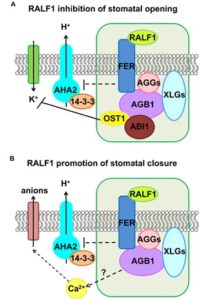 Plant Physiol. Heterotrimeric guanine nucleotide-binding (G) proteins participate in numerous processes including the regulation of hormonal responses and environmental stress. G proteins are composed of three subunits: Gα, Gβ, and Gγ. AGB1, a Gβ protein, forms a non-covalent dimer with a Gγ subunit, AGG. This AGB1-AGG dimer binds the Gα subunit GPA1. Yu et al. identified FERONIA (FER) as an interacting partner of AGB1, dependent on the presence of AGGs. FER is a receptor-like kinase (RLK) which acts as a receptor for RALF peptides. Exogenous application of RALF resulted in inhibition of stomatal opening in addition to the promotion of stomatal closure, both processes dependent on the presence of functional FER receptor and AGB1. OST1, a SNF-RELATED PROTEIN KINASE involved in ABA signalling, was also shown to interact with AGB1 and be involved in RALF inhibition of stomatal closure but, interestingly, is not required for RALF-mediated promotion of stomatal closure. These data elucidate RALF1 effects on stomatal dynamics, delineating differences in RALF mediated stomatal closure vs. inhibition of stomatal opening. (Summary by Alecia Biel) Plant Physiol. 10.1104/pp.17.01277.
Plant Physiol. Heterotrimeric guanine nucleotide-binding (G) proteins participate in numerous processes including the regulation of hormonal responses and environmental stress. G proteins are composed of three subunits: Gα, Gβ, and Gγ. AGB1, a Gβ protein, forms a non-covalent dimer with a Gγ subunit, AGG. This AGB1-AGG dimer binds the Gα subunit GPA1. Yu et al. identified FERONIA (FER) as an interacting partner of AGB1, dependent on the presence of AGGs. FER is a receptor-like kinase (RLK) which acts as a receptor for RALF peptides. Exogenous application of RALF resulted in inhibition of stomatal opening in addition to the promotion of stomatal closure, both processes dependent on the presence of functional FER receptor and AGB1. OST1, a SNF-RELATED PROTEIN KINASE involved in ABA signalling, was also shown to interact with AGB1 and be involved in RALF inhibition of stomatal closure but, interestingly, is not required for RALF-mediated promotion of stomatal closure. These data elucidate RALF1 effects on stomatal dynamics, delineating differences in RALF mediated stomatal closure vs. inhibition of stomatal opening. (Summary by Alecia Biel) Plant Physiol. 10.1104/pp.17.01277.
An extracellular network of Arabidopsis leucine-rich repeat receptor kinases
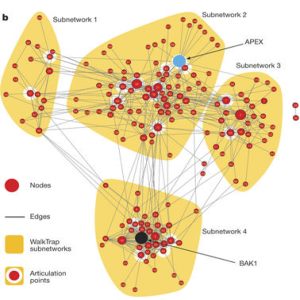 Nature. Through the activity of hundreds of membrane receptors, plants can sense the extracellular environment and tune their growth and responses to abiotic and biotic stimuli in an elegant and complex way. Despite their pivotal role, only a dozen of receptors have been characterized in plants and very limited is known about how they interact with each other to modulate their responses. In this pioneering study, Smakowska-Luzan et al. cloned and expressed in insect cell culture more than 200 Leucine-Rich Repeat Receptor Kinases (LRR-RK) from Arabidopsis thaliana and tested 40000 pairwise interactions. Among them, the screening allowed to identify 567 positive ones, therefore drawing a useful network map of LRR-RKs. Such a systematic approach led to “predict and validate the functions of uncharacterized LRR-RKs in plant growth and immunity” but, most importantly, represents a shift of knowledge towards a network biology approach in the field of membrane receptor kinases. (Summary by Marco Giovannetti) Nature. 10.1038/nature25184
Nature. Through the activity of hundreds of membrane receptors, plants can sense the extracellular environment and tune their growth and responses to abiotic and biotic stimuli in an elegant and complex way. Despite their pivotal role, only a dozen of receptors have been characterized in plants and very limited is known about how they interact with each other to modulate their responses. In this pioneering study, Smakowska-Luzan et al. cloned and expressed in insect cell culture more than 200 Leucine-Rich Repeat Receptor Kinases (LRR-RK) from Arabidopsis thaliana and tested 40000 pairwise interactions. Among them, the screening allowed to identify 567 positive ones, therefore drawing a useful network map of LRR-RKs. Such a systematic approach led to “predict and validate the functions of uncharacterized LRR-RKs in plant growth and immunity” but, most importantly, represents a shift of knowledge towards a network biology approach in the field of membrane receptor kinases. (Summary by Marco Giovannetti) Nature. 10.1038/nature25184
Regulation of lateral root development via the HY5 Transcription Factor
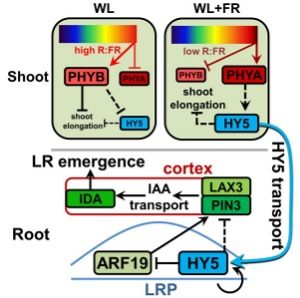 Plant Cell. Plants sense competitors through phytochromes. Phytochromes detect the reflection of far-red light from nearby plants, resulting in a reduced red:far-red (R:FR) ratio. The reduced ratio causes shade avoidance responses which modify shoot and root system architecture. This paper by van Gelderen and colleagues identifies a regulatory mechanism of root system architecture induced by light detection in the shoot using Arabidopsis thaliana. This novel mechanism is identified through microscopy, gene expression and mutant studies. Low R:FR is found to decrease lateral root density, which is regulated by the phytochrome-dependent accumulation of the HY5 (ELONGATED HYPOCOTYL 5) transcription factor. HY5 decreases the abundance of PIN3 (PIN-FORMED 3) and LAX3 (LIKE-AUX1 3) auxin transporters at the plasma membrane. This causes a reduction of the auxin signal to cortex cells, reducing the growth of lateral roots. This mechanism connects the sensing of light at the shoot to root structure and coordinates resource portioning. (Summary by Julia Miller) Plant Cell. 10.1105/tpc.17.00771
Plant Cell. Plants sense competitors through phytochromes. Phytochromes detect the reflection of far-red light from nearby plants, resulting in a reduced red:far-red (R:FR) ratio. The reduced ratio causes shade avoidance responses which modify shoot and root system architecture. This paper by van Gelderen and colleagues identifies a regulatory mechanism of root system architecture induced by light detection in the shoot using Arabidopsis thaliana. This novel mechanism is identified through microscopy, gene expression and mutant studies. Low R:FR is found to decrease lateral root density, which is regulated by the phytochrome-dependent accumulation of the HY5 (ELONGATED HYPOCOTYL 5) transcription factor. HY5 decreases the abundance of PIN3 (PIN-FORMED 3) and LAX3 (LIKE-AUX1 3) auxin transporters at the plasma membrane. This causes a reduction of the auxin signal to cortex cells, reducing the growth of lateral roots. This mechanism connects the sensing of light at the shoot to root structure and coordinates resource portioning. (Summary by Julia Miller) Plant Cell. 10.1105/tpc.17.00771
Hydrogen peroxide acts downstream of melatonin to induce lateral root formation
 Ann. Botany. Melatonin was first identified in plants in 1995. Since then, it has been found to be involved in many aspects of plant response to biotic and abiotic stress. Chen et al. investigate the effect of melatonin during lateral root (LR) development in alfalfa and Arabidopsis seedlings. Exogenous application of melatonin was found to increase H2O2 content in alfalfa seedlings as well as increased LR number, length, and density. This LR formation was impaired when melatonin treatment was supplemented with inhibitors of endogenous H2O2 production. Similarly, overexpression of a melatonin synthesis gene in Arabidopsis increased endogenous melatonin levels and H2O2 accumulation which enhanced LR formation. Blocking H2O2 production also inhibited melatonin-induced LR formation in Arabidopsis. Furthermore, transcript levels of two cell cycle regulatory genes related to LR formation were upregulated in both aforementioned alfalfa and Arabidopsis assays and negatively impacted by loss of H2O2. These data add to our knowledge of the melatonin pathway and its role in lateral root formation (Summary by Alecia Biel) Ann. Botany. 10.1093/aob/mcx207.
Ann. Botany. Melatonin was first identified in plants in 1995. Since then, it has been found to be involved in many aspects of plant response to biotic and abiotic stress. Chen et al. investigate the effect of melatonin during lateral root (LR) development in alfalfa and Arabidopsis seedlings. Exogenous application of melatonin was found to increase H2O2 content in alfalfa seedlings as well as increased LR number, length, and density. This LR formation was impaired when melatonin treatment was supplemented with inhibitors of endogenous H2O2 production. Similarly, overexpression of a melatonin synthesis gene in Arabidopsis increased endogenous melatonin levels and H2O2 accumulation which enhanced LR formation. Blocking H2O2 production also inhibited melatonin-induced LR formation in Arabidopsis. Furthermore, transcript levels of two cell cycle regulatory genes related to LR formation were upregulated in both aforementioned alfalfa and Arabidopsis assays and negatively impacted by loss of H2O2. These data add to our knowledge of the melatonin pathway and its role in lateral root formation (Summary by Alecia Biel) Ann. Botany. 10.1093/aob/mcx207.
A barley powdery mildew fungus non-autonomous retrotransposon encodes a peptide that supports penetration success on barley
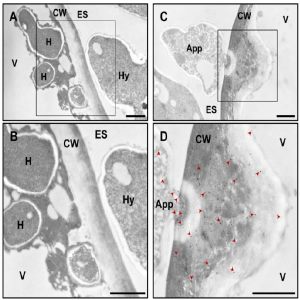 BioRxiv. Barley powdery mildew is an important asmocycete disease caused by the fungus Blumeria graminis f. sp. hordei. Previous literature in this field has investigated susceptibility genes as important targets to develop resistance. A well-known example of this, is the MLO gene, a negative regulator of basal resistance, loss of which is associated with mildew resistance. Another example is the small monomeric Rho of plants (ROP) GTPase HvRACB, whose constitutive activation supports haustorial growth into epidermal cells without the further induction of plant defence responses. In this work, Nottensteiner et al. have identified the HvRACB interacting Bgh protein ROP- interactive peptide 1 (ROPIP1) that is incoded on the Bgh SINE like retroposon Eg-R1. This newly identified intracellular virulence factor enhances Bgh growth in the epidermal cells when expressed transiently by particle bombardment. The protein is detectable in Bgh infected barley extracts and seen to be in hyphal structures and host cell cytoplasm when analysed by Transmission Electron Microscopy (TEM). RORPIP1 is recruited to the cortical microtubules by HvRACB modulator HvMAGAP1 and causes microtubule network destabilization. (Summary by Amey Redkar) BioRxiv. 10.1101/242271
BioRxiv. Barley powdery mildew is an important asmocycete disease caused by the fungus Blumeria graminis f. sp. hordei. Previous literature in this field has investigated susceptibility genes as important targets to develop resistance. A well-known example of this, is the MLO gene, a negative regulator of basal resistance, loss of which is associated with mildew resistance. Another example is the small monomeric Rho of plants (ROP) GTPase HvRACB, whose constitutive activation supports haustorial growth into epidermal cells without the further induction of plant defence responses. In this work, Nottensteiner et al. have identified the HvRACB interacting Bgh protein ROP- interactive peptide 1 (ROPIP1) that is incoded on the Bgh SINE like retroposon Eg-R1. This newly identified intracellular virulence factor enhances Bgh growth in the epidermal cells when expressed transiently by particle bombardment. The protein is detectable in Bgh infected barley extracts and seen to be in hyphal structures and host cell cytoplasm when analysed by Transmission Electron Microscopy (TEM). RORPIP1 is recruited to the cortical microtubules by HvRACB modulator HvMAGAP1 and causes microtubule network destabilization. (Summary by Amey Redkar) BioRxiv. 10.1101/242271
How to make a tumour: cell type specific dissection of Ustilago maydis-induced tumour development in maize leaves
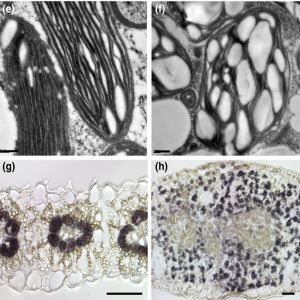 New. Phytol. Ustilago maydis causes corn smut disease on maize which is characterized by plant cancerous symptoms forming tumours on all aerial parts of host. The fungus deploys organ-specific effector proteins to re-program organ primordia to enormous tumours, however the cellular dissection of these symptoms remains unknown. Matei et al. have investigated the origin of these leaf tumours at tissue and cell-specific levels. The authors have analysed cytological and metabolite modulation to understand the cellular basis of tumorigenesis. Cell-type specific transcriptome profiling by laser capture microdissection in U. maydis infection identified bundle sheath cells as origin of hyperplasic tumour cells, while mesophyll cells to be undergoing hypertrophy by cell enlargement. Cell-specific expression of several fungal effectors is seen to be involved in the cell division trigger during tumour formation. Moreover, U. maydis effector See1 was identified as the first cell-specific fungal effector required for cell cycle activation specifically in bundle sheath cells. Hence this work sheds light on the abnormal symptoms that occur in this model phytopathogenic fungus. (Summary by Amey Redkar) New Phytol. 10.1111/nph.14960
New. Phytol. Ustilago maydis causes corn smut disease on maize which is characterized by plant cancerous symptoms forming tumours on all aerial parts of host. The fungus deploys organ-specific effector proteins to re-program organ primordia to enormous tumours, however the cellular dissection of these symptoms remains unknown. Matei et al. have investigated the origin of these leaf tumours at tissue and cell-specific levels. The authors have analysed cytological and metabolite modulation to understand the cellular basis of tumorigenesis. Cell-type specific transcriptome profiling by laser capture microdissection in U. maydis infection identified bundle sheath cells as origin of hyperplasic tumour cells, while mesophyll cells to be undergoing hypertrophy by cell enlargement. Cell-specific expression of several fungal effectors is seen to be involved in the cell division trigger during tumour formation. Moreover, U. maydis effector See1 was identified as the first cell-specific fungal effector required for cell cycle activation specifically in bundle sheath cells. Hence this work sheds light on the abnormal symptoms that occur in this model phytopathogenic fungus. (Summary by Amey Redkar) New Phytol. 10.1111/nph.14960
Extracellular ATP acts on jasmonate signaling to reinforce plant defense
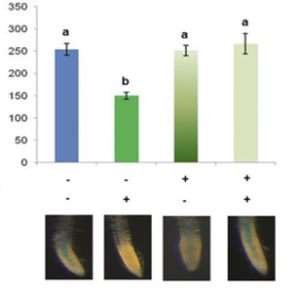 Plant Physiol. Extracellular ATP induces plant defense responses but the mechanisms involved are largely unknown. The paper by Tripathi et al. shows how extracellular ATP serves as a danger signal in plant defense and its interaction with the signalling pathways of other stress hormones, e.g. jasmonate (JA) and salicylic acid (SA). Using Arabidopsis thaliana leaves and ATP pre-treatments, the authors show the induction of resistance against the necrotrophic fungus, Botrytis cinerea which required intact P2K1, the receptor for extracellular ATP. Downstream signalling factors, after the recognition of extracellular ATP by P2K1 receptor, interact directly with (or modify) jasmonate ZIM-domain (JAZ) proteins to promote the formation of JA receptor, coronatine-insensitive1 (COI1)-JAZs complex, which coordinates ATP-JA synergism. Furthermore, ATP-activated JA signalling is an early event for the synergistic enhancement of JA-mediated plant responses. However, the event requires signalling via the second messenger trio, Ca2+, ROS, and NO and it is conceivable that ATP-induces dynamic and transient changes in the intracellular concentration of these second messengers directly impacting SA signalling. Also, during wounding, ATP-mediated NO might be involved in thioredoxin-mediated S-nitrosylation modifications of NPR1 (a key transcriptional regulator of the SA signalling pathway), therefore extracellular ATP may independently enhance JA and SA signalling. Hence this study shows the action of extracellular ATP on JA signalling. (Summary by Maria Julissa Ek-Ramos) Plant Physiol. 10.1104/pp.17.01477
Plant Physiol. Extracellular ATP induces plant defense responses but the mechanisms involved are largely unknown. The paper by Tripathi et al. shows how extracellular ATP serves as a danger signal in plant defense and its interaction with the signalling pathways of other stress hormones, e.g. jasmonate (JA) and salicylic acid (SA). Using Arabidopsis thaliana leaves and ATP pre-treatments, the authors show the induction of resistance against the necrotrophic fungus, Botrytis cinerea which required intact P2K1, the receptor for extracellular ATP. Downstream signalling factors, after the recognition of extracellular ATP by P2K1 receptor, interact directly with (or modify) jasmonate ZIM-domain (JAZ) proteins to promote the formation of JA receptor, coronatine-insensitive1 (COI1)-JAZs complex, which coordinates ATP-JA synergism. Furthermore, ATP-activated JA signalling is an early event for the synergistic enhancement of JA-mediated plant responses. However, the event requires signalling via the second messenger trio, Ca2+, ROS, and NO and it is conceivable that ATP-induces dynamic and transient changes in the intracellular concentration of these second messengers directly impacting SA signalling. Also, during wounding, ATP-mediated NO might be involved in thioredoxin-mediated S-nitrosylation modifications of NPR1 (a key transcriptional regulator of the SA signalling pathway), therefore extracellular ATP may independently enhance JA and SA signalling. Hence this study shows the action of extracellular ATP on JA signalling. (Summary by Maria Julissa Ek-Ramos) Plant Physiol. 10.1104/pp.17.01477
MicroRNAs from the parasitic plant Cuscuta campestris target host messenger RNAs
 Nature. Cuscuta sp. commonly known as dodder, is an obligate parasitic plant that colonizes a broad range of host plants and obtain water and nutrients by specialized feeding structure called haustorium. Literature suggests that this specialized structure is involved in bidirectional movement of viruses, proteins and mRNA between the host and parasite. Yet, the functional relevance of these movements is unknown. Shahid et al. in their recent work have performed a high-throughput small RNA-seq from varied tissues across different stages of parasitism with Cuscuta campestris grown on Arabidopsis thaliana. The authors identify small RNA producing loci from both the organisms. A. thaliana mRNAs are targeted by 22 nucleotide Cuscuta microRNAs thereby reducing the mRNA accumulation upon cleavage. The same miRNAs are expressed from Cuscuta when infected on Nicotiana benthamiana. Hence this study suggests that miRNA from Cuscuta campestris act as virulence factors during parasitism on different hosts. (Summary by Amey Redkar) Nature. 10.1038/nature25027
Nature. Cuscuta sp. commonly known as dodder, is an obligate parasitic plant that colonizes a broad range of host plants and obtain water and nutrients by specialized feeding structure called haustorium. Literature suggests that this specialized structure is involved in bidirectional movement of viruses, proteins and mRNA between the host and parasite. Yet, the functional relevance of these movements is unknown. Shahid et al. in their recent work have performed a high-throughput small RNA-seq from varied tissues across different stages of parasitism with Cuscuta campestris grown on Arabidopsis thaliana. The authors identify small RNA producing loci from both the organisms. A. thaliana mRNAs are targeted by 22 nucleotide Cuscuta microRNAs thereby reducing the mRNA accumulation upon cleavage. The same miRNAs are expressed from Cuscuta when infected on Nicotiana benthamiana. Hence this study suggests that miRNA from Cuscuta campestris act as virulence factors during parasitism on different hosts. (Summary by Amey Redkar) Nature. 10.1038/nature25027
Spatial and temporal patterns of mass bleaching of corals in the Anthropocene
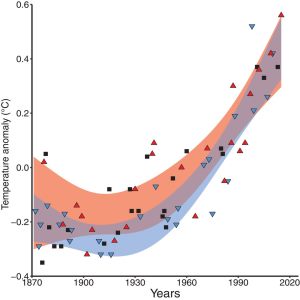 Science. As our ecosystems are changing rapidly, more studies are needed to document them. One of these important events is “coral bleaching”, a phenomenon that occurs due to environmental stress and when coral hosts lose their algal symbionts or zooxanthellae (Symbiodinium spp.), showing the white skeleton of the coral. Coral mortality is increased when bleaching occurs over several months, as bleached corals are physiologically and nutritionally compromised. In addition, thermal conditions for coral bleaching are more frequent nowadays indicating that the locations considered thermal refugia could disappear by mid-century. Hughes et al. in their recent work have compiled de novo history of recurrent bleaching from 1980 to 2016 for 100 globally distributed coral reef locations in 54 countries, using a standardized protocol to examine patterns in the timing, recurrence, and intensity of bleaching episodes, including the latest global bleaching event from 2015 to 2016. Their results indicate that the frequency of coral bleaching has increased as a cause of global warming. Coral bleaching events will probably be annual in the coming decades. The work appeals to increase our capacity to build resilience to these frequent events of coral bleaching by good management of local stressors. (Summary by Maria Julissa Ek-Ramos) Science. 10.1126/science.aan8048
Science. As our ecosystems are changing rapidly, more studies are needed to document them. One of these important events is “coral bleaching”, a phenomenon that occurs due to environmental stress and when coral hosts lose their algal symbionts or zooxanthellae (Symbiodinium spp.), showing the white skeleton of the coral. Coral mortality is increased when bleaching occurs over several months, as bleached corals are physiologically and nutritionally compromised. In addition, thermal conditions for coral bleaching are more frequent nowadays indicating that the locations considered thermal refugia could disappear by mid-century. Hughes et al. in their recent work have compiled de novo history of recurrent bleaching from 1980 to 2016 for 100 globally distributed coral reef locations in 54 countries, using a standardized protocol to examine patterns in the timing, recurrence, and intensity of bleaching episodes, including the latest global bleaching event from 2015 to 2016. Their results indicate that the frequency of coral bleaching has increased as a cause of global warming. Coral bleaching events will probably be annual in the coming decades. The work appeals to increase our capacity to build resilience to these frequent events of coral bleaching by good management of local stressors. (Summary by Maria Julissa Ek-Ramos) Science. 10.1126/science.aan8048



